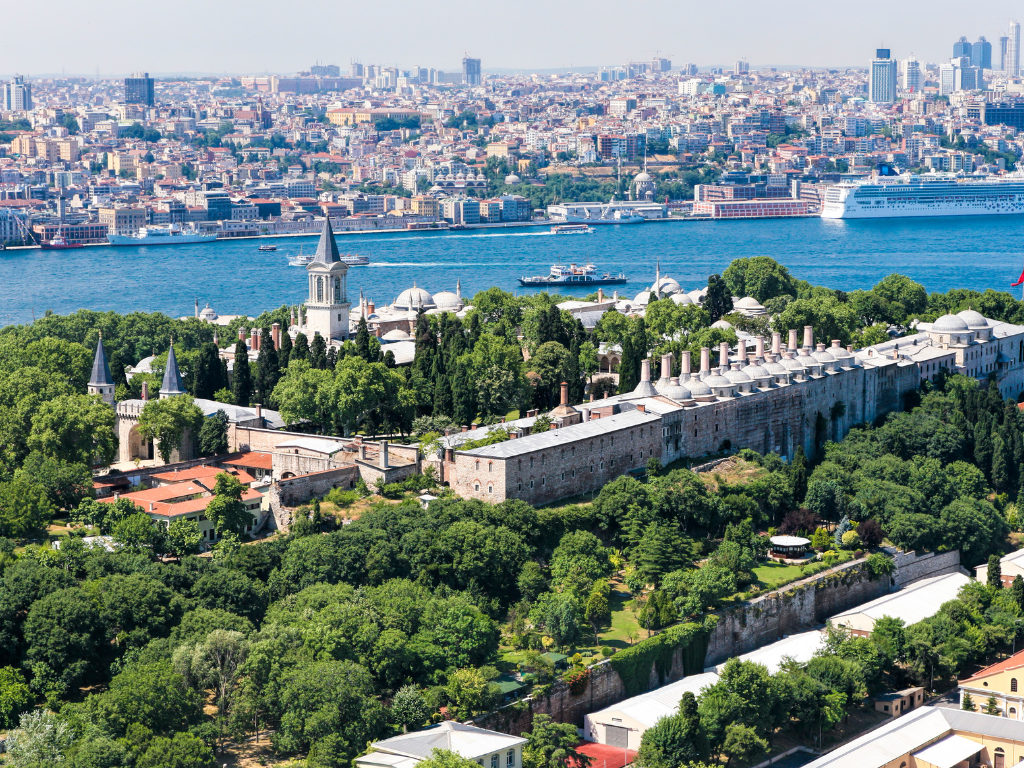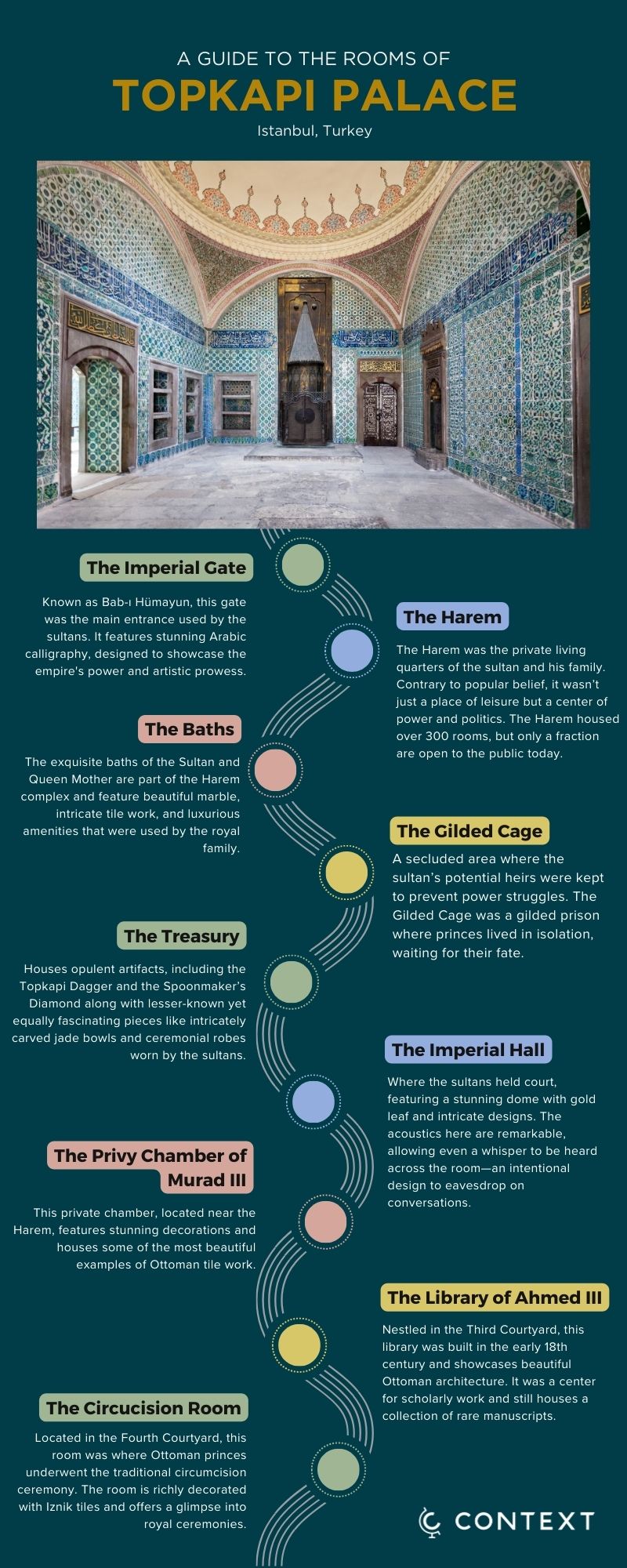Nestled on the Seraglio Point overlooking the shimmering waters of the Bosphorus and the Golden Horn, Topkapi Palace stands as a magnificent testament to the opulence and grandeur of the Ottoman Empire.
Can you smell the scent of roses or hear the call of the gulls in the distance? As you approach, the palace's towering domes and ornate minarets rise above the lush gardens, casting shadows over the cobblestone paths that have witnessed centuries of history.
For nearly 400 years, Topkapi Palace served as the primary residence of the Ottoman sultans and was the administrative center of the empire, making it one of the most significant historical landmarks in Istanbul. Join us on a journey to uncover the hidden gems and lesser-known details of this breathtaking monument.

Historical and Cultural Significance
Topkapi Palace is a jewel of Istanbul, embodying the might and splendor of the Ottoman Empire at the height of its power. Established by Sultan Mehmed II in 1459, shortly after his conquest of Constantinople, the palace served as the epicenter of Ottoman political, cultural, and social life for nearly four centuries. This grand complex was not only the sultan’s residence but also the hub from which the vast Ottoman territories were governed.
Political Center of an Empire
For centuries, Topkapi Palace was the epicenter of one of the world's most formidable empires. It housed the Imperial Council (Divan), where viziers and military leaders gathered to discuss state affairs and plan military campaigns. These meetings took place in the Council Hall, under the watchful eye of the sultan, who often listened from behind a latticed screen. This proximity to power underscores the palace’s role in shaping the geopolitical landscape of the era.
Architectural Marvel
Architecturally, Topkapi Palace is a masterpiece that reflects the diverse influences that characterized the Ottoman Empire. Its design incorporates elements of Islamic, Byzantine, and traditional Ottoman styles, creating a visual feast for the eyes. The sprawling complex, which covers over 700,000 square meters, features four main courtyards, each with its distinct purpose and aesthetic. From the grandeur of the Imperial Gate to the intricate details of the Harem, the palace's architecture tells a story of artistic achievement and imperial grandeur.

Cultural Hub
Topkapi Palace was also a cultural beacon, attracting scholars, artists, and craftsmen from across the empire. The palace libraries, particularly the Library of Ahmed III, housed countless manuscripts and works of literature. Here, you could find a rich intellectual environment. The court’s patronage of the arts resulted in the creation of exquisite works of calligraphy, miniature painting, and tile work, many of which are still on display in the palace today.
Sacred Relics
One of the palace’s most profound cultural contributions is its collection of sacred Islamic relics. The Chamber of Sacred Relics houses items of immense religious significance, including the Prophet Muhammad’s cloak, sword, and hair. These relics, which have been preserved and venerated for centuries, attract visitors from around the world, offering a deep spiritual connection to the Islamic faith.
Exploring the Hidden Gems of Topkapi Palace
Covering 350 hectares and holding four courtyards, seventeen exhibitions, and hundreds of rooms, exploring the palace can easily take half a day. Here are a few places you should be sure to see during your visit:
The Harem
Possibly one of the most well-known rooms in the palace, the Harem can only be accessed with a guide. These private living quarters of the sultan and his family served as a center of power and politics. Only a fraction of its 300 rooms are open to the public, but it played a crucial role in the Ottoman Empire's inner workings.

The Sublime Gate
Known as Bab-ı Hümayun, this gate was the main entrance used by the sultans. It features stunning Arabic calligraphy, designed to showcase the empire's power and artistic prowess.
The Holy Relics Room
This serene room houses relics of immense religious significance, including the Prophet Muhammad’s cloak and sword, his hair, and his bow and sheath. You can also find relics believed to have been used by Moses, Abraham, Joseph, and David. This room offers a tranquil contrast to the bustling palace grounds.
The Hidden Kitchens
The palace kitchens could prepare meals for up to 5,000 people daily. They were a culinary epicenter, featuring a diverse collection of Chinese porcelain that reflects the Ottomans' trade connections and taste for luxury.
The Gilded Cage
Also called Kafes, this was a secluded area within the Imperial Harem where the sultan’s potential successors were kept to prevent power struggles. The Gilded Cage was a gilded prison where princes lived in isolation, waiting for their fate.
The Imperial Council Hall
Here, the sultans held court. A stunning dome with gold leaf and intricate designs rises over the small rooms. The acoustics here are remarkable, allowing even a whisper to be heard across the room—an intentional design to eavesdrop on conversations.

The Treasury
This overwhelmingly magnificent complex houses opulent artifacts, including the Topkapi Dagger and the Spoonmaker’s Diamond. Beyond these well-known items, you can also find lesser-known yet equally fascinating pieces like intricately carved jade bowls and ceremonial robes worn by the sultans.
Hidden Gardens
Lush, secluded gardens offer a peaceful respite from the crowds. These gardens, with their greenery and blooming flowers, were a sanctuary for the sultan and his court.
The Library of Ahmed III
Nestled in the Third Courtyard, this library was built in the early 18th century and showcases beautiful Ottoman architecture. It was a center for scholarly work and still houses a collection of rare manuscripts.
The Circumcision Room
Located in the Fourth Courtyard, Ottoman princes underwent the traditional circumcision ceremony in this room which is richly decorated with Iznik tiles and offers a glimpse into royal ceremonies.

The Privy Chamber of Murad III
This private chamber, located near the Harem, features stunning decorations and houses some of the most beautiful examples of Ottoman tile work.
The Golden Road
This path in the Harem was used by the sultan to walk to the Queen Mother’s apartments. It’s said to have been strewn with gold coins on special occasions.
The Terrace of the Kiosk of Sultan Ibrahim I
Offering a stunning view of the Bosphorus, this terrace is a hidden gem where you can take in the breathtaking scenery and imagine the sultans enjoying their leisure time.
The Baths of the Sultan and the Queen Mother
These exquisite baths are part of the Harem complex and feature beautiful marble, intricate tile work, and luxurious amenities that were used by the royal family.
Visiting Topkapi Palace
Standing in the heart of Topkapi Palace, you are transported back to a time of unrivaled opulence and grandeur. The air is thick with history as you wander through its majestic halls and lush gardens, imagining the sultans and their courtiers who once walked these very paths. The intricate tile work, the delicate calligraphy, and the breathtaking views of the Bosphorus create a sense of awe and wonder.
 Each room and courtyard holds tales of power, intrigue, and artistry, surrounding you with the rich cultural tapestry that is the Ottoman Empire. A visit to Topkapi Palace is both humbling and inspiring, connecting you deeply to the past and the enduring legacy of this magnificent palace.
Each room and courtyard holds tales of power, intrigue, and artistry, surrounding you with the rich cultural tapestry that is the Ottoman Empire. A visit to Topkapi Palace is both humbling and inspiring, connecting you deeply to the past and the enduring legacy of this magnificent palace.
Ready to explore? Experience the Topkapi Palace with a Context expert beside you, filling you in on the stories of intrigue, fratricide, and politics that most visitors miss.














